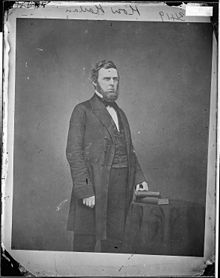James Harlan (Iowa politician)
James Harlan | |
|---|---|
 | |
| 8th United States Secretary of the Interior | |
| In office May 16, 1865 – August 31, 1866 | |
| President | Andrew Johnson |
| Preceded by | John Palmer Usher |
| Succeeded by | Orville Hickman Browning |
| United States Senator from Iowa | |
| In office March 4, 1867 – March 4, 1873 | |
| Preceded by | Samuel J. Kirkwood |
| Succeeded by | William B. Allison |
| In office January 29, 1857 – May 15, 1865 | |
| Preceded by | Himself (Election invalidated, as the Iowa Senate had not participated in it) |
| Succeeded by | Samuel J. Kirkwood |
| In office March 4, 1855 – January 5, 1857 | |
| Preceded by | Augustus C. Dodge |
| Succeeded by | Himself (Election invalidated, as the Iowa Senate had not participated in it) |
| Personal details | |
| Born | August 26, 1820 Clark County, Illinois, U.S. |
| Died | October 5, 1899 (aged 79) Mount Pleasant, Iowa, U.S. |
| Political party | Whig, Free Soil, Republican |
| Spouse | Ann Eliza Peck (1824–1884) |
| Alma mater | Indiana Asbury University |
| Profession | Politician |
James Harlan (August 26, 1820 – October 5, 1899) was an attorney and politician, a member of the United States Senate (1855–1865), (1867–1873) and a U.S. Cabinet Secretary at the United States Department of Interior (1865–1866) under President Andrew Johnson.
Biography
Early life
Harlan was the son of Silas and Mary (Connolly) Harlan. Born on August 26, 1820 in Clark County, Illinois and raised in Indiana, Harlan attended local schools as a boy. He graduated from Indiana Asbury University (now DePauw University) in 1845.
He moved to Iowa City, Iowa, where he served as Superintendent of Schools. He also studied law and was admitted to the bar in 1850. He joined the Whig Party and became active in politics. In 1850 Harlan declined the Whig nomination for Governor of Iowa. From 1853 to 1855 Harlan was president of Iowa Wesleyan College in Mount Pleasant, Iowa.
First Senate stint

In 1855 Harlan was elected by the Iowa legislature to the United States Senate as a Free Soil Party candidate. In 1857 the US Senate declared the seat vacant because of irregularities in that legislative election. He was re-elected by the legislature and seated as a Republican, serving until 1865. In 1861 Harlan was a Delegate to the Peace Conference that tried to arrange a compromise to prevent the American Civil War.
Secretary of the Interior
In 1865 he resigned from the Senate when he was appointed as Secretary of the Interior under President Andrew Johnson, an appointment he held until 1866. As secretary he announced that he intended to "clean house" and fired "a considerable number of incumbents who were seldom at their respective desks".[1] He had done so after requesting, in late May 1865, a report listing all employees who (1.) uttered disloyal statements since the bombardment of Fort Sumter, (2.) all those not known to entertain loyal sentiments or who had associated with those known to be disloyal, (3.) those who were inefficient or not necessary to transact public business, (4.) all such persons "as disregard in their conduct, habits, and associations, the rules of decorum, [and] propriety proscribed by a christian civilization."[2]
Among this group was the poet Walt Whitman, then working as a clerk in the department, who received his dismissal note on June 30, 1865.[3] Harlan had found a copy of Leaves of Grass on Whitman's desk as the poet was making revisions and found it to be morally offensive. "I will not have the author of that book in this Department", he said. "If the President of the United States should order his reinstatement, I would resign sooner than I would put him back."[4] Twenty-nine years later, Harlan defended his firing of Whitman, saying that the clerk was dismissed solely "on the grounds that his services were not needed".[1][5]
Harlan was a member of the Southern Treaty Commission that renegotiated treaties with Indian Tribes that had sided with the Confederacy, such as the Cherokee and Choctaw. As part of the new treaties, they had to emancipate their slaves, as was being done by amendment within the United States, and offer them full citizenship in the tribes if they chose to stay in Indian Territory. If they left, the freedmen would become United States citizens. (Membership issues related to the Cherokee Freedmen and Choctaw Freedmen have become significant since the late 20th century.) Harlan resigned from the post in 1866 when he no longer supported the policies of President Johnson.
Second Senate stint
He was elected again by the Iowa legislature to the United States Senate in 1867, and served until the end of his term in January 1873. During his Senate service, Harlan was Chairman of the committees of Public Lands; District of Columbia; Education; and Indian Affairs.
Harlan was an unsuccessful candidate for reelection in 1872, and was also an unsuccessful candidate for Governor in 1895.
From 1882 to 1886, Harlan was appointed as Presiding Judge for the Court of Commissioners, which heard cases related to the Alabama claims.
Death and legacy

James Harlan died in Mount Pleasant on October 5, 1899. A commemorative sculpture was done of him; Iowa installed it in the United States Capitol along with one of pioneer Governor Samuel Kirkwood (each state may install two statues for display in the Capitol). The Harlan statue was located in the Hall of Columns until it was replaced in 2014 by a statue of Norman Borlaug. It is now on display at Iowa Wesleyan College.[6]
Harlan was a close friend of President Abraham Lincoln and his family. In 1868 his daughter, Mary Eunice Harlan, married Lincoln's son Robert Todd Lincoln. The couple lived during the summers at Harlan's home in Mount Pleasant. The residence has been listed on the National Register of Historic Places and is now known as the Harlan-Lincoln House. Operated as a house museum, it exhibits memorabilia from both the Harlan and Lincoln families.[7]
Footnotes
- ^ a b Loving, Jerome. Walt Whitman: The Song of Himself. University of California Press, 1999. ISBN 0-520-22687-9. p. 291.
- ^ National Archives, RG48, Entry 14, James Harlan to Bureau Chief, May 29, 1865
- ^ Reynolds, David S. Walt Whitman's America: A Cultural Biography. New York: Vintage Books, 1995. ISBN 0-679-76709-6. p. 455
- ^ Kaplan, Justin. Walt Whitman: A Life. New York: Simon and Schuster, 1979. ISBN 0-671-22542-1. p. 304.
- ^ Peck, Garrett (2015). Walt Whitman in Washington, D.C.: The Civil War and America’s Great Poet. Charleston, SC: The History Press. pp. 137–40. ISBN 978-1626199736.
- ^ Petroski, William (August 18, 2014). "Harlan statue moved from D.C. to Mount Pleasant". Des Moines Register.
- ^ "Harlan-Lincoln House". Abraham Lincoln Online. Retrieved 2012-05-31.
External links
- 1820 births
- 1899 deaths
- United States Secretaries of the Interior
- United States Senators from Iowa
- People of Iowa in the American Civil War
- Union political leaders
- DePauw University alumni
- Iowa Whigs
- Iowa Republicans
- Iowa Free Soilers
- Republican Party United States Senators
- Free Soil Party United States Senators
- Andrew Johnson administration cabinet members



